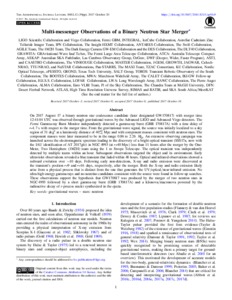Abbott, B P and Abbott, R and Abbott, T D and Somala, S N and et al, .
(2017)
Multi-messenger Observations of a Binary Neutron Star Merger.
The Astrophysical Journal Letters, 848 (2).
pp. 1-59.
![[img]](http://raiithold.iith.ac.in/4017/1.hassmallThumbnailVersion/The%20Astrophysical%20Journal%20Letters_848_12_1-59_2017.pdf)  Preview |
|
Text
The Astrophysical Journal Letters_848_12_1-59_2017.pdf
- Published Version
Download (3MB)
| Preview
|
Abstract
On 2017 August 17 a binary neutron star coalescence candidate (later designated GW170817) with merger time 12:41:04 UTC was observed through gravitational waves by the Advanced LIGO and Advanced Virgo detectors. The Fermi Gamma-ray Burst Monitor independently detected a gamma-ray burst (GRB 170817A) with a time delay of $\sim 1.7\,{\rm{s}}$ with respect to the merger time. From the gravitational-wave signal, the source was initially localized to a sky region of 31 deg2 at a luminosity distance of ${40}_{-8}^{+8}$ Mpc and with component masses consistent with neutron stars. The component masses were later measured to be in the range 0.86 to 2.26 $\,{M}_{\odot }$. An extensive observing campaign was launched across the electromagnetic spectrum leading to the discovery of a bright optical transient (SSS17a, now with the IAU identification of AT 2017gfo) in NGC 4993 (at $\sim 40\,{\rm{Mpc}}$) less than 11 hours after the merger by the One-Meter, Two Hemisphere (1M2H) team using the 1 m Swope Telescope. The optical transient was independently detected by multiple teams within an hour. Subsequent observations targeted the object and its environment. Early ultraviolet observations revealed a blue transient that faded within 48 hours. Optical and infrared observations showed a redward evolution over ~10 days. Following early non-detections, X-ray and radio emission were discovered at the transient's position $\sim 9$ and $\sim 16$ days, respectively, after the merger. Both the X-ray and radio emission likely arise from a physical process that is distinct from the one that generates the UV/optical/near-infrared emission. No ultra-high-energy gamma-rays and no neutrino candidates consistent with the source were found in follow-up searches. These observations support the hypothesis that GW170817 was produced by the merger of two neutron stars in NGC 4993 followed by a short gamma-ray burst (GRB 170817A) and a kilonova/macronova powered by the radioactive decay of r-process nuclei synthesized in the ejecta.
Actions (login required)
 |
View Item |


 Altmetric
Altmetric Altmetric
Altmetric